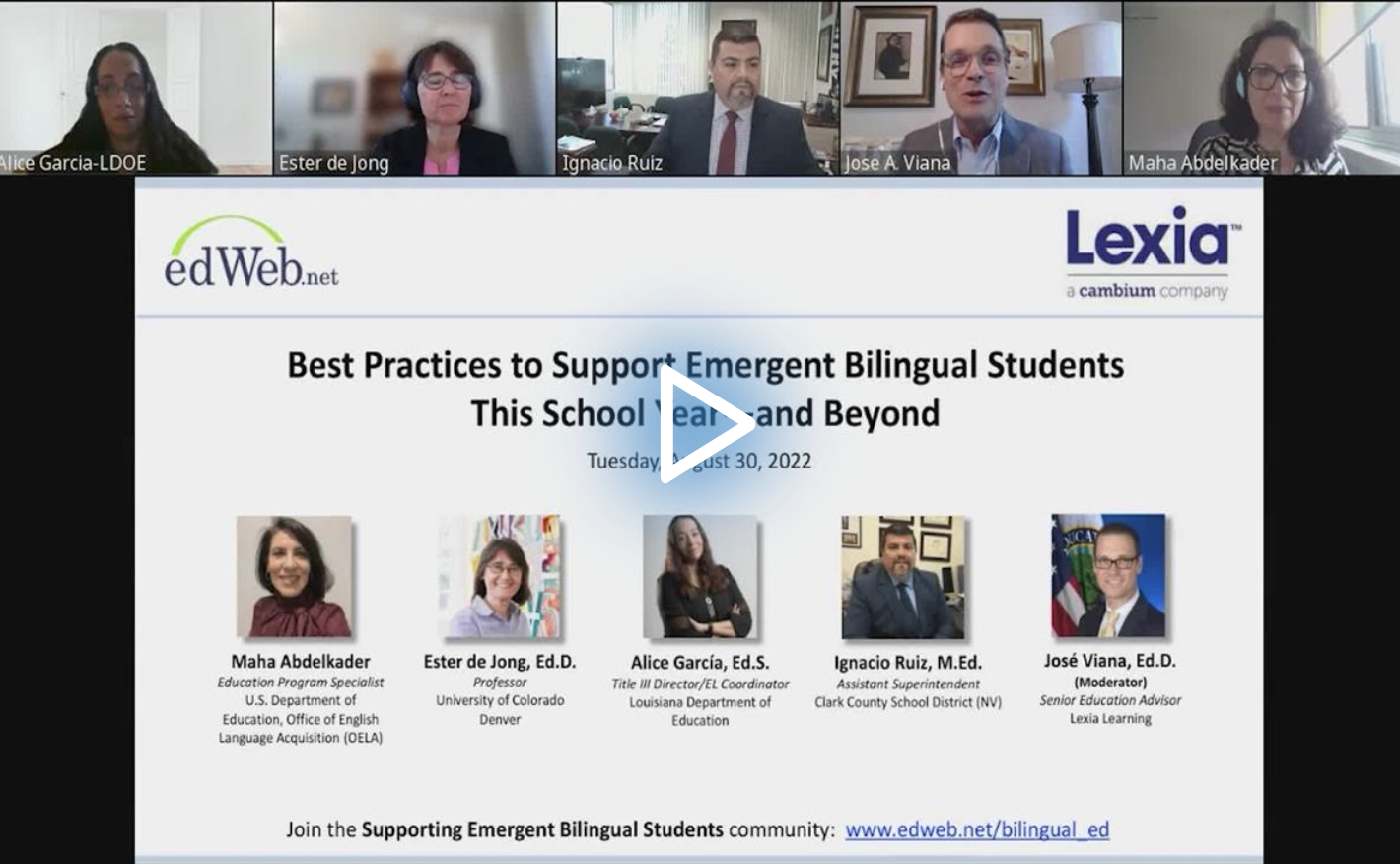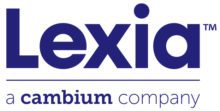Supporting Emergent Bilingual Students: Advice From the Experts
Watch the Recording Listen to the Podcast
Building a multilevel program to support emergent bilingual students is an effort that no one educator can take on alone. During the edLeader Panel, “Best Practices to Support Emergent Bilingual Students This School Year—and Beyond,” Dr. José Viana, Senior Education Advisor at Lexia Learning and the former Director of the Office of English Language Acquisition, hosted a panel of experts who explained how to build inclusive and asset-based learning environments at the national, state, district, and school levels. Panelists included:
- Maha Abdelkader, Education Program Specialist, Office of English Language Acquisition (OELA). OELA is the U.S. Department of Education’s division that guides national policy on asset-based approaches to multilingualism. Through research and data analysis, grants in the Title III Program, and thought leadership at a national level, Abdelkader explained how OELA creates and implements national policy that impacts the state departments of education and local districts.
- Alice García, Title III Director and EL Coordinator, Louisiana Department of Education. García provided listeners with a case study on how a state can translate OELA’s English language learning policies into practice. With a heavy focus on data collection, she explained how insights have helped build more effective tiered professional development programs, over 15 new two-way bilingual immersion programs for English learners, and equitable communities of practice that include stakeholders from all backgrounds in order to best support emergent bilingual students.
- Ignacio Ruiz, Assistant Superintendent, Clark County School District (NV). Ruiz explained how the fifth-largest district in the nation, with 16% of the student population identifying as emergent bilinguals, built an inclusive learning environment that honors the diversity of students’ lived experiences. With the majority of bilingual students immigrating from Spanish-speaking countries, Ruiz explained how policies like building a family support center for newcomer families, creating language tracks for students based on their needs, and providing targeted training for educators have helped the district to be strategic about providing differentiated support systems for English language learners in the short and long term.
- Dr. Ester de Jong, Professor, University of Colorado Denver. Starting with the premise that all students need a welcoming environment that affirms their identities, researcher and industry expert Dr. de Jong walked participants through how to create a welcoming environment in schools for both students and families. From communication practices to visual cues, she suggested that schools must ask themselves: What does it look like when students walk into school? What languages do they hear? Who do they interact with? What tone do we use when we communicate with parents? Are there authentic spaces for parental voices to be heard and included in the conversation?
After each panelists explained the role of their part of the educational system, Dr. Viana asked them to dive deeper into the building blocks behind what it takes to create welcoming learning environments for bilingual students.
- Best practices for creating a sense of belonging
- Though there are many levels to this process, Ruiz offered two concrete suggestions from Clark County’s experience. The first is to embed inclusive practices into professional education for administrators and educators so that they can then implement them directly with students. The second is to invite dialogue with students about how they feel about their cultures being included in the classroom, and include their voices in the process.
- In addition to these two suggestions, Lexia Learning developed a full checklist for creating a culturally responsive learning environment. Taking an asset-based approach, it is a valuable guideline for educators who want to build inclusive classrooms and schools for bilingual students.
- Use asset-based approaches to learning
- When asked, Abdelkader explained that language acquisition should be framed as an intellectual accomplishment for students. Educators who take this approach to English language learners will celebrate learning a second language and learning new content in that second language as an achievement. Some ways to concretely utilize the approach include recognizing that some students need additional time to learn and adjust their plans accordingly, or inviting students to use their heritage language to learn new content.
- García included that when educators celebrate diversity in a visual and proactive way, more students feel like they belong. For example, if there is a student who is advanced in speaking but struggles with writing, let them lead a group discussion to build up confidence in that area. Or, tap students who excel in different skills such as technology or drawing to become a teacher in the classroom in something other than language.
- Engage families
- In order to engage families, Ruiz explained that schools must provide meaningful access to understandable information in a variety of languages. After content is translated, educators can leverage resources such as community hotlines to reach more families and build powerful feedback loops that help the district to hone its approach and focus on interventions with the most impact. Abdelkader added that engaging families in a variety of roles becomes easier when school leadership deeply understands the context of the community. Engaging multiple pathways to reach parents and persistently finding communication strategies to reach families will improve the relationship between schools and communities.
- To complement these strategies, Lexia Learning built another checklist for engaging families. This tool can help district leaders and educators make sure they are doing everything possible to create a welcoming environment.
- Improve outcomes through differentiated lessons
- Dr. de Jong suggested that differentiation starts with programming in school. Then, educator training comes next. This helps to ensure that bilingual perspectives are integrated across content areas and that educators are thinking about how bilingual students are connecting with content. Often, ESL teachers can help general educators to evaluate and adjust this in their classrooms. Lastly, differentiating within the classroom helps to ensure that students are getting classes that are scaffolded to their ability levels.
- To support English language development, Lexia Learning has developed a program called Lexia English that helps English language learners start at their level and work their way through the content.
- Maintain a positive learning experience
- Lastly, to highlight the importance of a positive learning experience, García suggested starting with representation. There is nothing more powerful than seeing people who look like you or speak like you in the texts, videos, and content you are engaging with at school. This helps students to connect with the content and keep engagement high over a long period of time.
To close out, Dr. Viana shared the following takeaways from the discussion:
- All students need a welcoming learning environment
- Asset-based approaches to learning improve student wellbeing
- Engaging families can improve student outcomes
- Differentiated lessons help students learn at their own pace
- Every student deserves a positive learning experience
Learn more about this edWeb broadcast, “Best Practices to Support Emergent Bilingual Students This School Year—and Beyond,” sponsored by Lexia Learning.
Watch the Recording Listen to the Podcast
Join the Community
Supporting Emergent Bilingual Students is a free professional learning community that focuses on accelerating learning of bilingual and multilingual students by providing the asset-based instruction they need to perform as well as their monolingual peers.
Lexia® Learning, a Cambium® company, is one of the most impactful and highly respected reading-technology companies in the world. Founded over 35 years ago, Lexia’s research-proven programs help educators deliver personalized reading and language instruction for millions of K–12 students across the world.
Blog post by Laura Smulian, based on this edLeader Panel






Comments are closed.